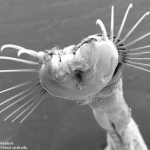
How do you find squid in the dark depths if you are a toothed whale or dolphin? Lindberg an expert on molluscs and Pyenson an expert on whale evolution propose that ecolocation in the ondontocetes, or toothed whales, arose as mechanism to locate squid buffets. To view this story we need to go back, way back.
45 million years ago the land mammals entered freshwater and evolved the necessary equipment to survive in an aqueous medium except obviously the ability to breath underwater. These first whales did not echolocate, which is known because their foreheads were not scooped to allow for “a fatty melon-shaped ball thought to act as a lens to focus clicking noises.” About 8 million years later you get dented foreheads in the whales about the same time they move into the ocean.

But what were the intermediate steps? “Lindberg and Pyenson propose that whales first found it possible to track [hard shelled cephalopods] in surface waters at night by bouncing sounds off of them, an advantage over whales that relied only on moonlight or starlight.” Thus when squid migrated into the depths over the course of day, whales could follow and forage. But then 10 million years ago, nautilus tired of losing all there nautiloid brethren moved from the open ocean to protected reefs. “Lindberg said that the decline in nautiloid diversity would have forced whales to perfect their sonar to hunt soft-bodied, migrating squid, such as the Teuthida, which in the open ocean are typically two feet long or bigger and range up to the 40-foot-long giant squid.”






Lindberg and Pyenson present a plausible follow-up to the pioneering works of Kenneth Norris (UCSC, et al) and Theodore Cranford (UCSD, et al). Check out Ted’s sight for some cool graphics…http://www.spermwhale.org/